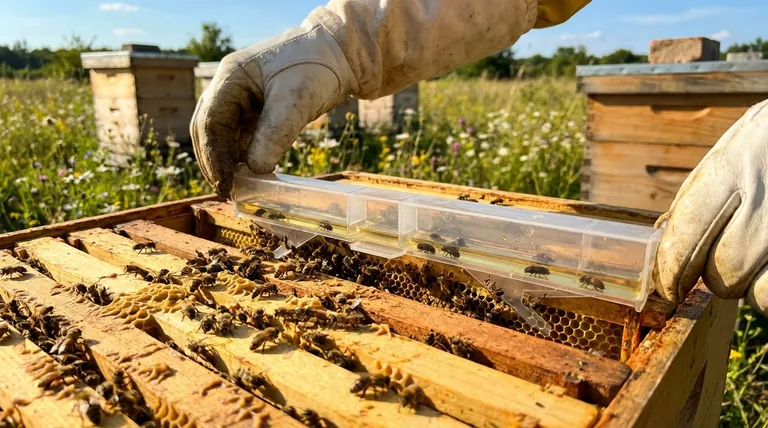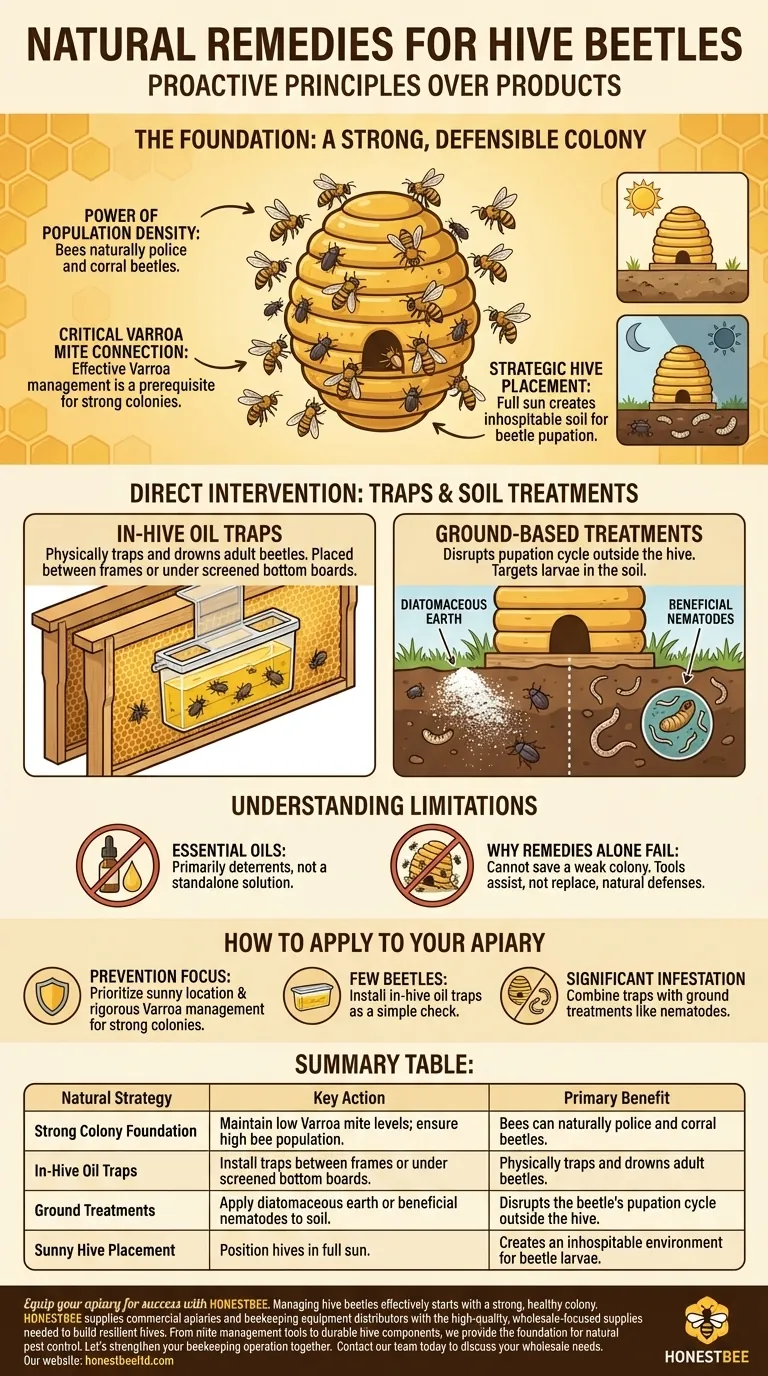When managing small hive beetles naturally, your primary tools are not products, but principles. While ground treatments like diatomaceous earth or beneficial nematodes can target the beetle's life cycle, the most effective and sustainable control comes from fostering an overwhelmingly strong and healthy bee colony that can defend itself.
Your core strategy against small hive beetles should be proactive, not reactive. The goal is to cultivate a bee colony so robust and populous that it can police the beetles on its own, rendering specific "remedies" a secondary line of defense.

The Foundation: A Strong, Defensible Colony
The single greatest defense against the small hive beetle (SHB) is a populous, healthy colony of bees. Beetles thrive in weak or struggling hives where they can overwhelm the bee population.
The Power of Population Density
A strong colony has enough worker bees to actively manage beetle incursions. The bees will "corral" the beetles, chasing them into cracks or imprisoning them in small propolis jails, preventing them from laying eggs in the brood comb.
A lower bee population cannot effectively police the hive, giving beetles free rein to reproduce.
The Critical Varroa Mite Connection
Varroa mites are a primary cause of weakened colonies. A hive struggling with a high Varroa load will have a diminished, sick, and stressed bee population.
This weakened state makes the hive an easy target for an SHB infestation. Therefore, effective Varroa management is a prerequisite for effective beetle control, especially in warm climates.
Strategic Hive Placement
Small hive beetles prefer shady, damp environments for their pupation stage, which occurs in the soil outside the hive.
Placing your hives in an area that receives full sun helps to create a less hospitable environment. The dry, warm soil makes it much more difficult for beetle larvae to successfully pupate and emerge as adults.
Direct Intervention: Traps and Soil Treatments
While colony strength is paramount, direct interventions can help reduce beetle pressure on the hive, especially during periods of high activity.
In-Hive Oil Traps
Physical traps are among the most effective non-chemical controls. These are typically small plastic reservoirs filled with mineral or vegetable oil.
Bees chase beetles into these traps, where the beetles then drown in the oil. These traps can be placed between frames or under a screened bottom board to catch beetles as they fall.
Ground-Based Treatments
Since SHB larvae pupate in the soil in front of the hive, the ground is a key control point.
Diatomaceous earth can be sprinkled on the ground to kill larvae as they crawl out of the hive to pupate. Beneficial nematodes are microscopic organisms that can be introduced to the soil, where they actively seek out and destroy beetle pupae.
Understanding the Limitations
Applying natural remedies without addressing the root cause of vulnerability is an exercise in futility. Understanding the limits of these methods is crucial for success.
The Role of Essential Oils
Essential oils like thyme or neem are sometimes cited as remedies. However, their primary function is as a deterrent or as an additive to traps, not as a direct treatment.
Applying oils directly inside the hive can be disruptive to the bees' own communication and behavior if not done with extreme caution. They are not a standalone solution.
Why Remedies Alone Will Fail
No trap or soil treatment can save a weak colony from collapse. If the bee population is too small or unhealthy to defend its own comb, beetles will inevitably overwhelm the hive and lay eggs, creating a destructive "slime out."
Traps and ground treatments are tools to assist a strong colony, not to replace its natural defenses.
How to Apply This to Your Apiary
Your approach should be tailored to your specific situation and overall beekeeping goals.
- If your primary focus is prevention: Prioritize a sunny apiary location and maintain a rigorous Varroa mite management schedule to ensure your colonies are always strong.
- If you are seeing a few beetles in a strong hive: Install in-hive oil traps as a simple and effective measure to keep the beetle population in check.
- If you are managing a significant infestation: Combine in-hive oil traps with a ground treatment like beneficial nematodes to attack the beetle's full life cycle, both inside and outside the hive.
By shifting your focus from searching for remedies to cultivating colony resilience, you empower your bees to become their own best defense.
Summary Table:
| Natural Strategy | Key Action | Primary Benefit |
|---|---|---|
| Strong Colony Foundation | Maintain low Varroa mite levels; ensure high bee population. | Bees can naturally police and corral beetles. |
| In-Hive Oil Traps | Install traps between frames or under screened bottom boards. | Physically traps and drowns adult beetles. |
| Ground Treatments | Apply diatomaceous earth or beneficial nematodes to soil. | Disrupts the beetle's pupation cycle outside the hive. |
| Sunny Hive Placement | Position hives in full sun. | Creates an inhospitable environment for beetle larvae. |
Equip your apiary for success with HONESTBEE.
Managing hive beetles effectively starts with a strong, healthy colony. HONESTBEE supplies commercial apiaries and beekeeping equipment distributors with the high-quality, wholesale-focused supplies needed to build resilient hives. From mite management tools to durable hive components, we provide the foundation for natural pest control.
Let's strengthen your beekeeping operation together. Contact our team today to discuss your wholesale needs.
Visual Guide

Related Products
- Reusable Clear Small Hive Beetle Traps for Beehives Beetle Trapping Tools
- Black Plastic Beetle Barn Hive Beetle Trap for Beehives
- Removable Washable Hive Beetle Trap Attractants for Small Hive Beetles
- Plastic Beetle Blaster Trap Beekeeping Tools and Supplies
- Professional Galvanized Hive Strap with Secure Locking Buckle for Beekeeping
People Also Ask
- What tips can help prevent hive beetle infestations? Build Strong Colonies & Master Apiary Hygiene
- What are the steps for installing hive beetle traps? A Guide to Effective Beetle Control
- What is the recommended number of beetle traps per hive? Optimize Your Hive's Beetle Defense
- What is the best time to use beetle traps? Master the Spring Strategy for Effective Hive Protection
- What are small hive beetles and where are they not indigenous? Protect Your Apiary from This Invasive Pest



















